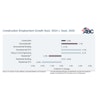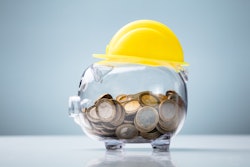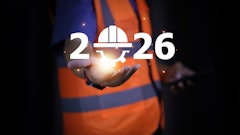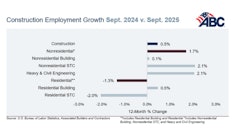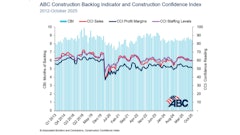
According to the Equipment Leasing and Finance Foundation, 42% of businesses plan to increase their equipment and software investments this year, with 32% citing increasing labor costs and labor shortages as the primary reason.
For construction companies navigating these pressures, the Trump Administration's “One Big Beautiful Bill Act” (P.L. 119-21) ("OBBBA") can bring significant tax relief to construction companies who are looking to modernize and grow their operations to meet rising demand while operating with a smaller workforce. The new tax legislation offers businesses greater certainty and improved cash flow opportunities compared to the previous provisions under the Tax Cuts and Jobs Act ("TCJA").
The State of Tax Provisions Under the TCJA
The OBBBA tax provisions come at a critical time for the industry. Many construction firms are facing multiple financial pressures from tariffs and the rising cost of materials in addition to ongoing workforce challenges. In fact, 94 percent of construction firms report difficulty filling open positions this year, and the Associated Builders and Contractors stated that the industry will need to attract approximately 439,000 new workers just to keep pace with demand.
While the TCJA was initially created to help firms navigate some of these economic strains, it created a lot of uncertainty that greatly impacted the industry.
The TCJA required businesses to capitalize domestic research and experimental (R&E) expenses and amortize them over five years, creating cash flow challenges for small and medium-sized businesses that rely heavily on research and development (R&D) investments.
Despite the strain caused by the R&E capitalization requirement, the TCJA did provide a major benefit to construction firms through 100% bonus depreciation for qualifying equipment placed in service between September 27, 2017, and December 31, 2022. This allowed businesses to immediately deduct the entire cost of eligible assets, stimulating investment in equipment and infrastructure. However, this provision began to phase out annually by 20% starting in 2023, with complete phase-out in 2027.
The TCJA offered another avenue of tax relief by increasing the maximum Section 179 deduction limit to $1 million, allowing profitable businesses to expense a greater portion of qualifying asset costs in the year of purchase. This deduction was phased out when purchases of qualifying assets exceeded $2.5 million. This provided financial relief for many construction firms, but these benefits were limited.
The OBBBA has addressed much of the instability brought on by the TCJA as it relates to tax and investment planning. It gives firms greater confidence to invest, grow, and tackle the cost challenges the industry faces today.
Uncertainty in Tax Planning and Its Consequences
While the OBBBA has addressed much of the instability caused by the TCJA, it’s important to understand the challenges firms faced under the previous tax provisions. The TCJA slowed down innovation for many companies while the industry was navigating digital transformation pressures.
By requiring companies to capitalize and amortize R&E expenses over five years, many activities were impacted, from software development to product testing. Companies found themselves paying taxes on income they had already reinvested in research, creating a financial burden that discouraged R&D tax relief.
While the introduction of 100% bonus depreciation was beneficial for many firms, the scheduled phase-out created challenges. Firms had to carefully time large investments to maximize tax benefits. It made it especially complicated to commit to multi-year capital roadmaps, complicating long-term investment decisions.
While Section 179 expenses brought benefits, larger firms faced restrictions. Since bigger equipment purchases weren’t fully deductible, firms had to spread deductions out over time. This constricted cash flow and made it difficult to plan for larger equipment investments.
Overall, the tax benefits under the TCJA required companies to conduct extensive planning by weighing the timing and scale of investments as well as evaluating tax benefits against business and operational needs.
The Shift to The One Big Beautiful Bill Act and Its Impact
Recognizing these challenges, the OBBBA provides more certainty and tax relief for construction and machinery firms. It extends the provisions of the 100% bonus depreciation so that it doesn’t sunset, increases the Section 179 expense limits, and reverses one of the most criticized aspects of the TCJA by permanently restoring immediate deductions for domestic R&E expenditures, providing businesses with the cash flow benefits they need to fuel innovation and growth.
By taking advantage of the OBBBA, construction and machinery firms can ease their tax burden and free up budgets to invest in modern machinery and advanced technology that can create more efficient workflows, help meet safety standards, scale with new projects, and stay competitive in the industry. With clear guidelines on which assets qualify for deductions, firms can confidently plan investments that align with their capital needs.
Taking Full Advantage of The New Bill
To fully leverage these opportunities, construction and machinery firms should utilize these major tax provisions to support modernizing their operations:
R&E Deductions: The OBBBA introduces IRC Section 174A, which permanently allows businesses to deduct domestic R&E expenditures in the year incurred. Companies can elect to capitalize and amortize domestic R&E expenditures over at least 60 months, beginning when they first realize benefits from the spending. Under IRC Section 59(e), taxpayers can elect to capitalize and recover domestic R&E expenditures over 10 years, providing additional flexibility for tax planning. The Act explicitly states that amounts paid for software development can be treated as R&E expenditures, removing previous uncertainty in this critical area.
100% Bonus Depreciation: Reinstating and making 100% bonus depreciation permanent removes any uncertainty that firms previously had. Firms can receive immediate tax benefits by deducting the full cost of equipment in the year it is placed in service. This improves the cash flow for companies and encourages investments in new equipment or technology.
Section 179 Limits: These expense limits are raised to $2.5 million with a $4 million phase out. This can help firms to purchase and deduct larger equipment and software, further aiding innovation for the industry.
Financing Growth Through Tax Relief
By taking advantage of these tax provisions, construction and machinery firms can have an easier time financing growth and modernizing operations. R&E expensing historically had little impact on construction companies, but now design-build and safety-focused contractors are utilizing technology to streamline processes and to meet more safety standards. In fact, it’s becoming more common for contractors to develop their own ERP and safety systems, for example, all of which could qualify for the R&D credit, providing significant tax relief.
These tax provisions not only support industry innovations, but they also address a major challenge – rapid machine turnover. The typical life span for heavy equipment is between 5-10 years (or 5,000–10,000 hours) with proper upkeep. However, this lifespan is usually shortened due to the high maintenance costs. Many heavy machines reach the end of their economically viable life well before their theoretical maximum life, and contractors frequently delayed purchases or took on debt to replace worn-out machines. With the OBBBA’s 100% bonus depreciation, firms can write off equipment within a year without hurting the cash flow, allowing contractors to update, maintain and expand their equipment.
Beyond cash flow opportunities, the OBBBA provides the certainty and flexibility that the industry needs to plan for the future. At a time when the industry is facing financial pressures and labor shortages, these provisions give firms the opportunity to improve efficiency with a leaner workforce, scale for growth and remain competitive. Looking ahead, firms that take full advantage of these benefits will emerge as industry leaders, playing a critical role in advancing America’s infrastructure for decades to come.




